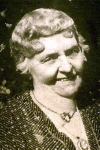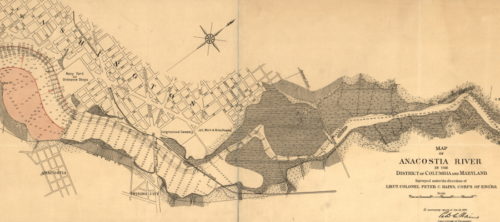 When researching Hill history, I often come across names for geographical features that are no longer in use, such as Garrison Street or Navy Yard Hill or Carroll’s Spring Today, I’ll look at a more sinister name once belonging to a landmark which – like Carroll’s Spring– no longer exists.
When researching Hill history, I often come across names for geographical features that are no longer in use, such as Garrison Street or Navy Yard Hill or Carroll’s Spring Today, I’ll look at a more sinister name once belonging to a landmark which – like Carroll’s Spring– no longer exists.
The Anacostia River today is fairly benign, swinging through the eastern edge of Capitol Hill and down to the Potomac. In earlier years, it was quite a bit more dangerous, and unpredictable. Different in particular was how the river looked at high and low tides. At high tide, it spread across a fairly wide area; at low tide was much more constrained – and circuitous.
This meant that there was a particularly sharp bend right about where the extension of C Street Northeast would cross the river. This zigzag was notorious enough to have earned the name “Devil’s Elbow.”
While not a new name – as early as 1843, a Devil’s Elbow existed on Plaquemines Bayou in Louisiana – the name was apt. Over the years, a number of people drowned there. For instance, in 1896, a sixteen-year-old named Ellis Horsey drowned there after being struck by a cramp. Sometimes, it was not directly the dangerous waters that claimed its victims, in 1908, an explosion of a gasoline-powered boat caused the death of two people, one of whose bodies was recovered at “the lower end of the Devil’s Elbow,” according to the September 21, 1908 Washington Post.

Detail of an 1891 map of the Anacostia showing what is presumably Devil’s Elbow off the end of East Capitol Street.
Note the difference in the river at high and low tide. The large area of shaded ground is not a swamp, but simply the difference between the high and low-water mark.
(North is not at the top, but points up and to the right) (LOC)
The most notorious drowning there actually occurred in 1880. In this case, it was not necessarily the treacherous waters that were at fault, but quite possibly an intentional drowning. The victim was Jacob Scheitlin. The Evening Star of April 10, 1880 reported that someone had stopped by a police station to say that “he had discovered the body of an unknown white man, floating in shore on the north side of the Eastern Branch, at a point known as the Devil’s Elbow, just in the rear of the poor-house which he had secured to a stake in the water.”
Presumably, it was the body thus secured, not the poor-house.
The body was examined and discovered to be that of Jacob Scheitlin, a Swiss-born draftsman whose wife had died a few years earlier. In his pocket was discovered a letter that said “My wish is that I have Christian burial in some spot, only that after my death I do not come in contact with hypocritical and false-swearing people. My two boys, my spirit will aways watch over you.” (Mistakes in spelling and grammar may or may not have been in the original, the Star does not indicate where they crept in)
Scheitlin does not mention his daughter Anne Marie Scheitlin (pic), though it is she that makes the story interesting, for she, 15 years later, gave birth to none other than J. Edgar Hoover.
Scheitlin was buried in Congressional Cemetery, where I am sure there are neither “hypocritical” nor “false-swearing people.”
Devil’s Elbow is no longer used on the Anacostia – it is where the southern tip of Kingman Island is today – and seems to have fallen out of favor as a term for any geographical feature generally. However, it was used through much of the early 2oth Century to describe what we would today call a hairpin turn.
